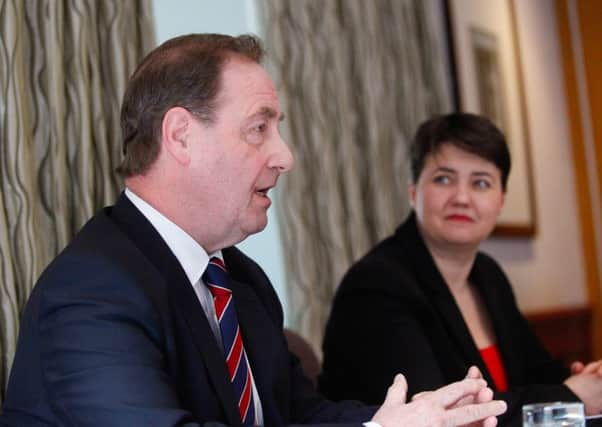Leaders: Right to ease tax burden on '˜squeezed middle'


A proposal to introduce a new income tax band to ease pressure on Scotland’s “squeezed middle” comes as the Scottish Parliament gets ready to set rates from April 2017 onwards.
According to the Commission for Competitive and Fair Taxation in Scotland, a group set up by the Scottish Conservatives, Scotland’s overall tax burden should be lower than the rest of the UK “when affordable”.
Advertisement
Hide AdAdvertisement
Hide AdThe commission has proposed the creation of a new middle band of income tax between the current 20 per cent and 40 per cent bands, at around 30 per cent.
In a report published yesterday, the commission said the change would “ensure fewer aspirational families are dragged into the higher tax rate band” of 40 per cent.
The commission, which comprises business leaders and economic experts, also called on Scottish politicians not to raise the 45 per cent top rate of income tax.
And it called for the council tax to be replaced with a “more local, fairer and progressive” property tax, with reliefs aimed at low-income households across all bands.
Commission chairman Iain McMillan is absolutely right when he says that political debate in Scotland now needs to focus not just on spending, but also on matters of tax. That debate must be informed, so it is to be welcomed that the commission has been set up.
It is to be hoped that all the parties will now come up with fully-costed proposals on tax.
There is always some tension around easing the tax-take to encourage growth.
The SNP has, in the past, been advocates of lower business taxes to encourage more inward investment.
Advertisement
Hide AdAdvertisement
Hide AdDuring the referendum, a key pledge was that corporation tax would be lowered below the UK rate after independence.
In simple terms, higher levels of disposable income tend to create more stimulus for the economy overall.
That said, cutting tax for high earners is not exactly a major departure for the Scottish Conservatives, a party which has been keen to paint itself as having a distinct identity from its Westminster counterparts.
Mr McMillan said yesterday that implementing the new lower rate for higher earners was likely to raise less money through tax in the short term.
However, he said “the attractiveness of the tax rate and the incentive to work and earn more” would result in more tax yield over time.
Scottish Labour leader Kezia Dugdale has said her party would use an increase in the top rate to tackle the attainment gap in schools.
For its part, the SNP has said it is in favour of “progressive taxation”, with the party backing restoration of the 50p top rate of tax during last year’s general election.
Mr McMillan warned such a measure could “drive out wealth creators and deter new ones from coming to Scotland”.
More details are needed on all of these plans.
Advertisement
Hide AdAdvertisement
Hide AdHowever, it is to be welcomed that tax will increasingly become a key battleground in the run-up to the Holyrood elections.
Damning gender imbalance
First Minister Nicola Sturgeon made increasing the number of women in top jobs a key commitment when she took up her post in 2014.
Yet research published today shows the Scottish Government continues to “lag behind” England and Wales when it comes to the number of women in top Civil Service posts.
According to professional services firm EY, the proportion of senior Civil Service posts in the Scottish Government that are held by women dropped to 35 per cent in 2015, the same level as in 2011.
In contrast, the rate rose in England from 35 per cent in 2011 to 39 per cent in 2015, while in the Welsh government 47 per cent of leading Civil Service posts are held by females, up from 38 per cent in 2011.
The First Minister was rightly praised for making gender equality a key focus of her term in office. Under the 50:50 by 2020 initiative, boardrooms in the both the public and private sector are being encouraged to make room for more women.
But despite warm words, progress has been glacial.
Last year, research by independent think-tank Fiscal Affairs Scotland found the gap in pay between men and women in Scotland was widening despite closing elsewhere in the UK. Separate research by the Law Society of Scotland found male solicitors earn as much as 42 per cent more than their female counterparts.
Today’s research is particularly damning for the first minister, as civil service jobs are the one area she should be able to directly influence. Much was made of Ms Sturgeon’s gender-equal cabinet, but without similar changes elsewhere in society it is nothing more than a gimmick.